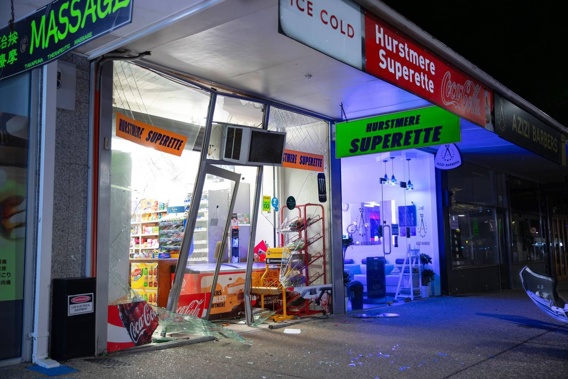

Most New Zealanders believe youth crime is getting worse. Statistics and research shows the opposite is true. The generations born since the 1990s are coming before the courts less often, and there has been a big drop in the numbers going to prison. Open Justice reporter Ric Stevens investigates what’s really going on.
Despite talk of rampant youth crime, Generation Z – that cohort of New Zealanders now in their teens and early 20s – are less likely to get into trouble with the law than any other age group in decades.
There are a small number of them who do flout the law and they tend to do it spectacularly, often by ramming a stolen vehicle into a shop and posting about it on TikTok.
This offending is highly visible, and it has a big impact on the besieged shop owners and communities around them, which is why the public rightly get alarmed.
Generally, people believe youth crime is getting worse. Surveys suggest 87 per cent of New Zealanders believe it has increased in the past five years. This belief, however, is contrary to what statistics tell us.
Overall, Ministry of Justice data shows youth crime rates dropping year on year.
The trend is not always consistent, and there has been a significant post-Covid uptick, but the number of children and youths aged 16 or under coming before the courts has halved over the past decade.
And within those statistics are some numbers that illustrate the difference between Generation Z – those born between 1996 and 2010 – and their seemingly less law-abiding older brothers and sisters.
/cloudfront-ap-southeast-2.images.arcpublishing.com/nzme/D5MIDHC6AVCPTMYZUINMD7J3SM.jpg) Generation Z - those born between 1996 and 2010 - spend more time online, drink less alcohol and go to prison less frequently than their older brothers and sisters. Photo / 123RF
Generation Z - those born between 1996 and 2010 - spend more time online, drink less alcohol and go to prison less frequently than their older brothers and sisters. Photo / 123RF
In 2010, the rate of children - aged 10 to 13 - who offended stood at 208 per 10,000. In other words, about 99.8 per cent of children did not get into trouble with the law.
By 2018, a year for which directly comparable data is available, the rate of child offenders had more than halved - to 93 per 10,000.
Another key measure is incarceration rates.
New Zealanders born in 1989 had a one-in-50 likelihood of ending up in prison before the age of 21. For New Zealanders born 10 years later, in 1999, that dropped to a one-in-200 chance.
That shift is one of the key factors changing the demographics of the prison population, which is getting older on average. The other is the increased number of sex offenders going to jail, who tend to be older when first convicted.
According to a multi-agency government Long-term Insights Briefing (LTIB) report on prison trends, the average age of people in prison was 25 in 1980, and 38 in 2022.
Fewer young people are getting non-custodial sentences.
Eight per cent of people born in 1989 had experienced a community-based sentence by the age of 21, but just 3 per cent of those born in 1999 had done so.
This means not only are younger adults not entering prison so frequently, they are also not getting tangled up in the wider criminal justice system as much.
The number of police warnings, issued before the matter gets to court, has also been declining in the key age groups.
Overall, the number of children and young people aged 16 or under who have charges resolved in the courts halved from 2268 in the year to June 2014 to just 1104 in 2023.
Something different is happening
“Birth cohort analysis makes it clear that the decline in youth crime is not simply a product of the changing age structure of society - ie, the fact that there are proportionately fewer young people,” the LTIB report said.
“There is something different happening for subsequent generations of young people.”
/cloudfront-ap-southeast-2.images.arcpublishing.com/nzme/EMPT5UABRZDPZFRATIKMERTJTM.jpg) Generation Z are now in their late teens and early 20s.
Generation Z are now in their late teens and early 20s.
The exact nature of this “something different” is still being researched. Overseas studies, however, suggest a number of factors.
One of them is that there are fewer opportunities for young people to commit “gateway” crimes – relatively minor offences that lead to other, more significant, offences.
An example is car theft. People are more likely to lock their cars these days but most modern vehicles are also more difficult to steal, including those with factory-fitted immobilisers.
And if youths are not converting cars and joyriding with their mates, they are less likely to be stepping onto the next rung up on the crime ladder – for example, driving carelessly or dangerously, or driving drunk.
Young people’s routine activities have changed – they spend more time at home online and less in public spaces.
While the internet has its own risks, and it is possible that young people are engaged in online criminality that goes undetected, online activity also tends to divert people from wrongdoing in the real world.
Generation Z also drink less alcohol than their elders, and over time they have been binge-drinking less. Alcohol is recognised as an “offending-related factor” by justice system professionals.
Surveys by the Alcohol Healthwatch organisation show the proportion of New Zealand secondary students drinking alcohol has fallen significantly, and those who do drink are consuming less.
The proportion of secondary students who said they have never drunk alcohol (other than a few sips) was 26 per cent in 2007. This increased to 39 per cent in 2012, and to 45 per cent in 2019.
None of these things alone can explain the downward trend of youth crime statistics, but taken together, they restrict some of the pathways that can lead young people into trouble.
Then there are changes to the way youth justice operates.
The Youth Court was established by ground-breaking legislation in 1989, which established the principle - among others - that criminal proceedings should be used for children or young people only as a last resort.
/cloudfront-ap-southeast-2.images.arcpublishing.com/nzme/TVUE4H2GBCV3CNHZOUSXF3U3SE.jpg) Professor Ian Lambie, the chief science adviser for Justice, says there is a "trauma to prison pipeline". "Basically, you don’t get a child offending as a teenager severely who hasn’t come from a violent, abusive background," he says. Photo / Supplied
Professor Ian Lambie, the chief science adviser for Justice, says there is a "trauma to prison pipeline". "Basically, you don’t get a child offending as a teenager severely who hasn’t come from a violent, abusive background," he says. Photo / Supplied
The youth justice system now works on the basis of diversion, and aims to resolve offending without young people receiving a criminal conviction, while still having regard to public safety.
This principle is based on experience which shows once a young person enters the formal justice system and receives a criminal record, they are more likely to develop a pattern of offending and their offences may get more serious.
About 90 per cent of young offenders are now kept out of the courts. Minor offences are dealt with by the police either through warnings, or referral to Youth Aid for an action plan.
Diversion is the key
The chief science adviser to the justice sector, clinical psychologist Professor Ian Lambie, of Auckland University, also says the youth justice system is doing an “exemplary job”.
“For the vast majority of kids, diversion is the key,” Lambie told NZME.
“It’s far better to take a restorative process, and rather than saying what’s wrong with this kid, reframing that and saying, what happened to this kid, how can we support them, how can we get around them?” he said.
“I have to applaud the vision of the Youth Court judges and the Chief Justice in this space. They are doing an amazing job. And working also with community groups, iwi, mana whenua, etc, other NGOs [non-government organisations], that is where the solution lies, honestly.”
Lambie contrasted the New Zealand system with what he saw in the United States, where he visited recently.
He said the systems there were far more punitive and criminalising of adolescents - or juveniles as the Americans call them - leading to more young people moving into the adult justice system.
“Once they’re in the adult system they’re gone, and it is not only an expensive thing financially for governments and taxpayers, but it also doesn’t result in a reduction in victims. It kind of makes the issue worse.”
/cloudfront-ap-southeast-2.images.arcpublishing.com/nzme/56APZ37TXVAWXIKTJH4OZZ4SMU.jpg) Inside Korowai Manaaki, the youth justice residence in Auckland, in 2017. Photo / Michael Craig
Inside Korowai Manaaki, the youth justice residence in Auckland, in 2017. Photo / Michael Craig
The LTIB report also said another reason youngsters were not offending was that attitudes towards young people have changed, resulting in “better parenting and other supports”.
This connects to another factor that has influenced criminal offending over past decades: the burden of being abused as a child while in the care of the state.
The LTIB report said people born between the mid-1960s and the 1980s were the generations that experienced the highest levels of involvement with state care, including residential care.
Research for the Royal Commission of Inquiry into abuse in state care suggests that as many as 250,000 children were abused while in the care of the State or faith-based organisations.
Its research also found that between 32 and 35 per cent of people who experienced state residential care as a child between the 1960s and the 1980s later went to prison as an adult.
Generation Z did not experience such a high level of involvement in state residential care, and they also benefited from what criminal justice professionals call “protective factors” that steer people away from criminal offending.
Statistics New Zealand data shows cohorts of 17-year-olds in the past decade are more likely to leave school with a qualification, and are less likely to have been suspended from school.
They are less likely to have been the subject of intervention by Oranga Tamariki and are less likely to have grown up in a household primarily dependent on an income benefit.
All of these factors have been identified as contributing to a child’s likelihood of becoming an offender.
Today’s young people are also more likely to have called on mental health services when they needed to.
Despite all these factors helping young people out of trouble with the law, clearly a proportion of them are still offending, and some of them appear to revel in it.
It’s basic parenting
So what makes them different from their peers? A good place to look for answers is within ram-raid offending, because it is one area that has been more deeply analysed after becoming a political issue.
A police study in 2022 identified 79 of the worst young ram-raiders from an examination of thousands of charges laid.
It found they all came from unstable, impoverished households with poor parenting and inconsistent role models, where they had been victims or witnesses of family violence.
They all had “poor or non-existent” engagement with school, lived in social circles where offending was normalised, and began offending between the ages of 12 and 14.
They all had fathers who were engaged with the criminal justice system, either as frequent offenders or spending time in prison.
/cloudfront-ap-southeast-2.images.arcpublishing.com/nzme/LUJJBSFKGJCVVPLDCZGJKU5OHM.jpg) Nike on Broadway was ram raided early on September 11.
Nike on Broadway was ram raided early on September 11.
Police said this was in line with previous studies which showed that young offenders have typically suffered abuse and neglect, came from impoverished families and had left or been stood down from school.
Lambie said evidence suggested further improvements in youth justice required a “developmental crime prevention” focus, which meant focusing on early intervention.
People with therapeutic expertise should work alongside cultural groups, NGOs and schools to help children at risk and their families.
“What we need is people in the homes teaching these people, these parents, not to bash their kids, not to yell at their kids, how to love their kids,” he said.
“It’s basic parenting stuff.”
Ric Stevens spent many years working for the former New Zealand Press Association news agency, including as a political reporter at Parliament, before holding senior positions at various daily newspapers. He joined NZME’s Open Justice team in 2022 and is based in Hawke’s Bay. His writing in the crime and justice sphere is informed by four years of front-line experience as a probation officer.

Take your Radio, Podcasts and Music with you









